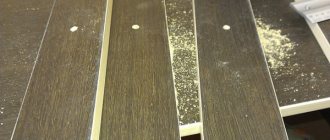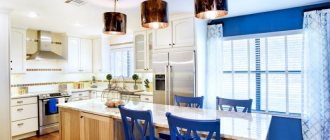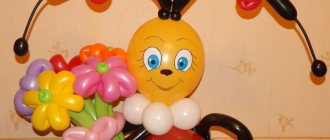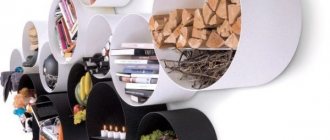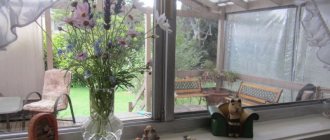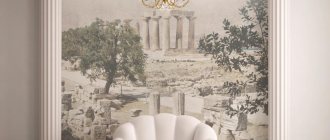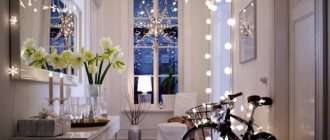Where to start
Any finishing, in construction, room decoration or decorative art needs preparation. Before you start decorating an old piece of furniture, you need to remove the old paintwork. You can use all suitable means for this: from sandpaper to special solvents. It can be especially difficult to work with Soviet lacquered tables, because they were made to last.
Whatever method of removing old paint or varnish you choose, you cannot skip the next step: the table must be thoroughly cleaned with fine sandpaper.
Then the item is inspected for cracks or holes that need to be repaired with wood putty. The dried composition must be sanded again.
The next mandatory step is applying a primer. This is the only way to be sure that the decorative layer will not fall off over time, and that the varnishes/paints will apply more evenly. After the primer mixture has dried, you can begin decorating.
There are several ways to decorate a coffee table, and we will tell you about them.
How to choose a coffee table
By what principle do people usually choose furniture? Many will agree that this often happens according to the principle “I came, I saw, I conquered.” However, is this correct? Even for such a small interior element as a coffee table, this is completely wrong. First of all, when choosing this piece of furniture, you should consider the following:
- living room style;
- color design, even if it is a bright accent of the interior, it should ideally match the colors used in the room and fit harmoniously into the design of the room;
- square footage of the room and directly the place to place the table, especially when it comes to a small living room in an apartment.
Decoupage
The name of the technique itself is translated from French découper - “cut”. It consists of attaching (gluing) a cut-out design, ornament, or painting to an object. Then the decorative layer is varnished to ensure the durability of the pattern.
To decorate a table using the decoupage technique, you can use various elements:
- old newspapers, books, music notebooks;
- wallpaper remnants;
- patterns and ornaments cut from disposable paper napkins;
- family photos;
- pictures cut out from magazines;
- pieces of fabric.
The prepared surface of the table is covered with PVA glue and the necessary elements are laid out. Using a rubber roller or plastic spatula, smooth the surface, removing bubbles. After the glue has dried, coat it with several layers of varnish.
You can apply the ornament on top of a painted table, and sand the edges, creating a worn effect. This table will look original in a Provence, country or shabby chic room. But this is only true for wooden furniture.
You can also decorate a coffee table using the decoupage technique by choosing a lace pattern for the tabletop.
Coffee tables in the interior: at the origins of tradition
The official history of this invariable attribute of any living room began in England in the mid-19th century, and it was during this century that its rapid rise in popularity occurred. But the origins of this aristocratic furniture are not as clear as it might seem at first glance. At least, there are several versions according to which such a table came into European culture and became part of the design of houses in European countries. But in most cases, they all boil down to the fact that coffee tables in European interiors appeared under the influence of Eastern culture.
Such furniture was popular even during the Ottoman Empire, as well as among the Japanese samurai. In both cases, such small and easy-to-use tables were intended for outdoor tea ceremonies. Most likely, a passion for the colorful East and the desire to provide comfortable traditional English tea drinking contributed to the penetration of coffee tables into the interiors of European living rooms. They have come a long way in improvement.
and are now presented in a variety of variations from any materials, different shapes, colors and equipped with all kinds of decorative decorations.
Decorating a table with painting
Even if you don’t have any artistic painting skills, your table can still become interesting and original. You can decorate a coffee table with painting using acrylic paints (sold at any art supply store) and a stencil.
When choosing shades and patterns, be guided by the style of the interior. It is not at all necessary to use flowers, monograms and “curls”; you can also refresh the surface with the help of geometric shapes.
You should also immediately decide whether your drawing will have a background, and what kind. Most often, neutral shades are used so that the painting itself does not get lost, but stands out. When the background paint has dried, apply a stencil and apply the pattern with a brush or roller. You can decorate the entire surface or part of it. If necessary, you can use masking tape to protect those areas where you do not plan to apply the pattern. When the paint has dried, you can outline the contours of the design with a thin brush - this step may be necessary in those places where the stencil did not fit tightly and the design has spread.
The painting on top must be protected with several layers of varnish.
Please note: regular acrylic varnish can be used for protection, but parquet varnish will create a more durable coating. However, it smells too much, so it is better to work in the fresh air.
Decorating a coffee table using craquelure technique
Craquelure translated from French craquelure
means a crack in a layer of paint or varnish, giving a special “aged” look to an ordinary thing.
Among designers and decorators, a similar technique is used in conjunction with decoupage in such style directions as shabby chic (shabby chic) and Provence.
To create artificial aging you need 3 compositions:
- paints of two contrasting colors, one of which plays the role of a “substrate”, the second - an aged layer;
- and, in general, a special craquelure varnish applied over the first paint.
Pronounced cracks look very original, but for this you need to choose two contrasting paint colors.
If no painting or other decor is planned on top of the aged paint, then it is better to varnish the dried layer for better preservation.
How to decorate a table with stickers
Surely many of you have seen decorative vinyl stickers in stores intended for interior decoration. But who said that they can only be glued to walls? This method of decoration is the simplest and least expensive in terms of time and finances.
However, if you decide to choose this method, it does not mean that preparing the table surface can be neglected. It will also have to be sanded and primed, and maybe even painted, creating a certain background for the ornament. The selected elements are glued onto a dry and clean surface and carefully smoothed. If necessary, the decorated tabletop can be varnished.
Ceramic tile
There are no limits to the imagination of modern designers and a variety of materials are used to achieve a certain goal.
If none of the above methods for decorating a coffee or coffee table suit you, pay attention to the following unusual methods.
You can decorate the surface of any table in an original way using ceramic tiles. The only difficulty is to select the required quantity according to the size of the table. You can decorate it in different ways: lay out an original panel in the center, framed with monochromatic elements, or come up with a geometric pattern (zigzag, checkered pattern, squares, herringbone) - such decor will look original and fresh.
How to decorate a coffee table with ceramic tiles: master class
For work you will need:
- the tile itself or a panel made from it;
- adhesive composition (you can use liquid nails or dilute special tile adhesive);
- spacer elements “crosses” (the smaller they are, the thinner the joints between the tiles will be);
- you can use any grout, but epoxy is more practical and reliable;
- rubber spatula for applying grout;
- notched glue spatula;
- sponge;
- several clean napkins (both wet and dry).
First, decide on the pattern of how you will lay out the tiles: it is better to lay them out on a flat surface so that the pattern on the panel matches. The tiles should be laid the way they will lie on the table.
Then the material needs to be prepared: wipe the tiles from dust with a napkin - the back part should be dry and clean. We hope you have already prepared the surface of the table.
Apply the adhesive composition to the surface of the table with a notched trowel, laying each tile on it, carefully pressing down with your hands so that there are no bumps. Place crosses between the elements. Wipe the adhesive off the face of the tiles as needed.
Please note: you should not apply glue to the entire surface of the table at once, otherwise it will have time to dry by the time you reach the last tiles.
After gluing, leave the table to dry for at least a day.
The next step is to fill the joints with grout. We hope you have chosen the appropriate composition and read the instructions on how to use it. Fill all the seams with a rubber spatula; remove excess with a damp sponge. As you fill, remove all spacer crosses from between the tile joints. If necessary, create seams using either your gloved fingers or a rubber spatula.
Once all the seams are filled, remove excess grout from the face of the tiles with a dry cloth, being careful not to touch the seams. Leave to dry for at least a day. Wet cleaning of the table can be carried out according to the instructions on the grout packaging.
Decorating a coffee table with mosaics
Mosaic is a universal element for decoration; it decorates not only aprons in the kitchen or niches in the bathroom, but also mirrors, panels and furniture. The only difficulty is correctly calculating the size and number of necessary elements for the table area.
The decorating process consists of gluing mosaics in the desired order, forming a pattern, ornament or some simple picture. Modern mosaics are usually sold on a grid, but if necessary they can be easily cut with scissors into the required pieces. Moreover, the mosaic elements themselves can have different sizes and shapes. As for the material from which mosaics can be used, there is no limit to the variety: wood, glass, ceramics, metal, and plastic. Tables decorated with shards of old ceramic tiles look very original.
For gluing, you can use any suitable glue, applying it with a notched spatula to the prepared surface of the table. After the mosaic elements have dried, the seams are also filled with grout (it is better to use epoxy). Clean the surface with a damp cloth.
Types of coffee tables by material of manufacture
- Wooden
Wooden coffee tables are classics that remain timeless. Even with a wide range of more stylish modern materials for making such furniture, wooden tables do not lose popularity. These interior items are made from plastic, metal, and fine wood.
Such tables will fit perfectly into the classic style, successfully emphasizing all the rigor, sophisticated elegance and design. However, there are quite budget variations that will look good in a country interior or in a country house in the best traditions of rustic or eco-style. Their significant advantage can be numerous additional decorative decorations (carvings, paintings, inlays). If you do not forget about the rules for caring for wooden furniture, then wooden coffee tables in your interior will serve you well for many years, remaining a special highlight of the living room in your home.
- Glass
The glass coffee table will fit perfectly into any modern interior style. For a high-tech style living room this will be the best option. Such airy furniture is suitable for any interior designed in the spirit of minimalism. It will give the room the illusion of more space and add a feeling of airy lightness to the atmosphere of such a living room. Although such tables seem incredibly fragile and unreliable, in fact, modern technologies make it possible to create not only exquisite, but also quite durable glass products.
- Forged
Such tables are durable, reliable, practical and at the same time not devoid of refined appeal, bordering on aristocratic luxury. The only thing that is definitely worth considering is the combination of this type of furniture with the interior styles that are most appropriate for its location. A wrought-iron coffee table will harmoniously fit into a home whose atmosphere is designed in an oriental style, and will also become an elegant addition to a living room in a Moroccan style.
Harmony of different materials
No less relevant are varieties that are a combination of different materials. For example, one of the most popular options that successfully combines special luxury and elegance is a metal or wrought iron coffee table with a marble top. of glass and metal looks especially harmonious
.
Mirrors
Mirrors have always added mystery and expansion to a home. Reflective surfaces, whether on the wall or on furniture, always increase space and are appropriate in the smallest rooms. Well, by decorating a coffee table with a mirror, you can get an unusual piece of not just furniture, but decor. You can use either the whole canvas or its small pieces. A mirror mosaic or a “broken” mirror looks original, refracting more light. To get small pieces, the mirror cloth can be placed between two wet wipes and lightly tapped with a hammer - this will prevent the fragments from scattering to the sides.
Most often, only the table base is decorated with a mirror, but you can go even further and decorate the legs of the table by ordering a mirror of the required size in the workshop:
Please note: to fix the mirrors, you must use a special glue that does not damage the back part - the amalgam.
Well, the legs can be easily repainted in the desired color.
Glass
There are several ways to use glass to decorate a coffee table.
- Option 1: using glass with photo printing. Glass with an applied ornament or photo printing is simply glued to the base, and the legs can be painted in any color. Frosted glass with ornaments will be original.
- Option 2: bars are attached around the perimeter of the tabletop, on which the glass is laid. Any items for decoration are placed under it: colored sand, buttons, beads, shells, pebbles, memorable items. It is better to attach glass to the bars, but for this you need to make holes in it (it is better to order glass where they can do this).
- Option 3: very thick glass is used, simply placed on the tabletop, and photographs, compositions of dry leaves, fabric or paper are placed under it. Since the material is very heavy, there is no need to fasten it; with its weight it will tightly press all the elements.
You can decorate the glass with your own hands: on the back side (the one that will lie on the table) any design is applied through a stencil. This move is relevant if your table has a glass top, but you want to update its appearance. You should choose colors that contrast with the table; you can use both stained glass and acrylic paints - they are more resistant to moisture and safe, since they do not emit toxic substances into the air.
Furniture and interior items
91 votes
+
Vote for!
—
Vote against!
The word "decor" means decoration. Having paints, wallpaper, pictures, mosaics, and natural materials on hand, you can decorate any piece of furniture, and even more so create original decor for a coffee table.
To do this, it is enough to decide what is available, choose the appropriate equipment and recharge with determination by studying the proposed ideas. So, here are a few options for you to turn an old coffee table into, at a minimum, an original interior decoration, and at a maximum, a work of art.
Types of coffee table decoration:
- decoupage;
- mosaic;
- painting;
- craquelure.
You can decorate a coffee table:
- mirrors;
- shells;
- wooden blocks.
As they say, there would be a table. Even if it is old, creaky, unattractive, it can be an excellent basis for creating a new creative household item. Let's see how the masters do it.
- Decoupage
- Mosaic
- painting
- Craquelure
- Mirrors
- Shells
- Wooden blocks
- Veneering
Decoupage
Decoupage is the application of paper or fabric to a surface. To decorate a coffee table, its surface is first primed and sanded, and then coated with paint.
A layer of PVA glue is applied to the dried layer of paint, and on it:
- decoupage card (finished parts);
- a piece of paper napkin (previously freed from the second layer);
- photos;
- textile;
- lace.
The entire dried image is covered with several layers of varnish. This technique allows you to give an original look to even the most ordinary wooden table. It will bloom like a lawn, turn into a world map, or become a storage place for old photographs.
The easiest option is to cover the table with wallpaper or fabric. It is important to secure the edges well and smooth the surface moistened with glue. Using push pins (with a shiny solid head) you can add some flair to your table.
A separate article is devoted to coffee table decoupage.
Mosaic
You can decorate a coffee table with your own hands using mosaics. To do this you need to prepare the following materials:
- spray paint;
- sandpaper;
- mesh tiles - mosaic;
- glue;
- grout.
Tools you can't do without are a brush for applying glue, a spatula and scissors.
1. Paint the table and let it dry well.
2. Cover the area to apply the tile pattern with glue.
3. Apply the prepared fragment of tile, press it and also let it dry.
4. The seams between the tiles must be thoroughly treated with grout, and then washed off from the surface of the tile.
Tip: before grouting, cover well the surface of the table that does not have tiles.
The result is an original and practical table. If you master the technique, you can take on more complex patterns.
painting
You can decorate anything with paint! It is enough to have 2 contrasting colors to create a bright pattern. Here you can show your talent and paint the table by hand, or you can make a stencil and apply an image on it. It can be butterflies, flowers, ornaments and much more. For your attention – contrasts when decorating a coffee table with your own hands: a red star on a white background.
For this we need:
- white and red paint;
- paper stencil;
- varnish
1. We clean all irregularities on the table surface, prime and sand if necessary.
2. Cover the product with white paint and let it dry.
3. Prepare the stencil. To do this, print out the drawing (possibly in black and white) on large format paper (the smaller the drawing, the simpler it is). We cut out the pattern with a knife.
4. Fix the stencil on the tabletop, carefully cover all other elements of the table and apply red paint.
5. After drying, the stencil is removed, and if necessary, the edges of the image are drawn with a brush or contour.
6. Using paint polish will make the design brighter and more shiny.
Craquelure
Craquelure is a method of artificially aging a surface, when either craquelure varnish or improvised means such as egg white, PVA glue, vinegar or gelatin are applied to a not completely hardened layer of paint. The technique allows you to achieve a cracking effect on the surface. Cracks, depending on the materials, can be very different - from large to the smallest cobwebs. It looks good using 2 contrasting colors. The second layer is applied after the first has dried slightly.
To create a decorative coffee table, you can combine craquelure and decoupage techniques. In this case, the cracking effect can cover the entire surface, on top of which napkin designs are applied using the decoupage technique, and then varnish is applied.
Mirrors
A mirrored table will look great in a modern interior. To make it, you will need:
- base box made of chipboard;
- silver (spray paint);
- mirrors;
- liquid Nails.
1. We make a base box of any suitable size from plywood or chipboard. We pay special attention to the places where the sheets are fastened.
2. Cover the entire structure with silver.
3. We cut out ourselves or order 5 mirrors from the workshop, corresponding to the area of the edges of the box.
4. We glue the mirrors with liquid nails.
5. Carefully remove traces of glue.
6. Fix the mirrors until dry with masking tape.
Shells
Seashells in the interior are always a reminder of summer and the romance of the sea coast.
Shells decorate finished glass tables with double bottoms. But you can try to build such a table yourself from wood, bamboo, twine and glass, decorating it with shells.
Materials you will need:
- plywood (sheet thickness - 2-3 cm);
- thick glass (at least 1 cm);
- thick and thin bamboo sticks;
- twine (2-3 m);
- silicone gaskets;
- fastening tools (nails and screws).
1. Decide on the dimensions of the future table.
2. Cut out a piece of glass and plywood of the same size. If the base is already there, then plywood is not needed.
3. We attach a bamboo frame to the table base or plywood blank (we use bamboo with a large diameter).
4. We nail twine with small nails along the edge of the plywood or the existing surface of the table.
5. We coat the bamboo and twine with varnish.
6. Drill holes in the bamboo frame for attaching silicone gaskets (at least 2 holes on each side).
7. Beautifully lay out shells, corals, natural and artificial stones in the resulting niche inside the bamboo frame.
8. To add style to the entire structure, we decorate the table legs with thin bamboo.
Wooden blocks
An excellent table made from blocks will suit an interior where there are a lot of colors and the finishing is done with natural materials. Before decorating a coffee table, you will need to select a dry, even, without unnecessary knots birch log, the diameter of which is about 10 cm.
1. Prepare a wooden or plywood box of the required size. Its lower bottom should be 10 cm away from the walls.
2. Measure its height and add 2 cm. This will be the length of the blanks that need to be cut from the log.
3. After the log is sawn, each piece is sanded to remove roughness.
4. The bars are installed on the protruding part of the bottom of the box, along the perimeter. To do this, they are placed on glue (the bottom and the side adjacent to the box are coated) and fastened together.
5. To finish the tabletop, the log is cut into identical pieces 2 cm thick. They are laid out on the table, having previously coated each with glue.
6. The holes between the workpieces are rubbed.
7. The finished table is sanded again and then varnished.
8. The structure will be heavy, so it is better to equip it with wheels.
Decorative coffee tables would be especially appropriate in a country house or country cottage. They are easy to make and look very stylish! At the same time, you can experiment with the location of the pads.
Veneering
If a coffee table in a classic style fits better into your interior and you already have a table, but its surface has become worn out, then you can easily change it. Veneering is used for this. This is gluing thin sheets of veneer onto the surface, which is performed using the hot and cold method. Thus, you can imitate any type of wood.
An important condition for achieving a good result will be the presence of screw clamps or a press, which are used with the cold veneering method, which is more appropriate at home. But you can also apply veneer using PVA glue and an iron. To do this, coat the surface with glue, wait until it dries, lay a sheet of veneer, a white sheet of paper on top, and then apply a hot iron on top. It is important here to prevent the veneer from swelling, and if bubbles appear, to properly get rid of them. To do this, a small hole is made in the bubble with a needle, through which excess air or glue is expelled. Then this place is further processed with an iron. Once the veneer is applied, the edges are carefully trimmed and sanded. The last stage is coating the product with varnish.
The decor of the coffee tables, photos of which we showed you, is quite accessible even to a novice craftsman. A few trial lessons and we are sure your coffee table will turn out even better!
Decorating a table with wood
As strange as it may sound, any table, even a wooden one, can be further decorated with the same wood. However, this requires some work skill (the ability to cut it to size). Or order a cut at a workshop.
To turn a regular old coffee table into a fashionable one with a wooden top, you need to:
- Take all measurements: for correct cutting you need to know the width and length of the tabletop.
- Cut (can be done in production) wooden lining or ordinary beams, clean if necessary.
- Cover with stain or varnish of the desired color. In the meantime, prepare the table itself: clean it and coat it with primer.
- Using liquid nails or any glue intended for wood, glue the planks to the table, place a weight or secure with clamps.
- If necessary, seal the seams between the planks (you can use epoxy grout or a sealant of a matching color).
Another way to decorate a coffee table is to stick wood cuts on the tabletop - such a decoration looks original and unusual. The space between them is filled with epoxy resin. By the way, they can also be placed under glass.
Another way to give an old table base the texture and color of wood is veneering . But for this you will need sheets of natural wood veneer (not all construction centers have them). Such sheets are mounted on a prepared tabletop using PVA glue and smoothed with a hot iron through sheets of white paper.
Thus, using different shades of wood veneer, you can lay out a pattern or ornament. If desired, the surface is varnished for protection.
Please note: during the process of gluing veneer, air bubbles may form, which must be removed immediately: just pierce the problem area with a needle and “blow off” the air, then go through it again with a hot iron.
If you don’t have the opportunity or desire to tinker with natural wood, you can go a very simple route, but your table won’t last long: go and buy a self-adhesive PVC film “like wood.”
Classification by type
Currently, with the development of design ideas, you can see not only primitive tables, but also tables made of modern and sophisticated materials with an unusual design.
By type, coffee tables are divided into several types:
Practical: they have a fairly large, comfortable tabletop and various shelves to ensure maximum functionality.
Transformable: involve transforming a coffee table into an alternative furniture attribute - chairs, a sofa with wooden armrests, or a sleeping place.
The most current trend is turning a coffee table into a standard dining table.
Decorative: created mainly for interior decoration, therefore they are very rarely used directly for their intended purpose.
Decorating a coffee table with coins: master class
How to beautifully decorate an old coffee table at the lowest cost? Use coins! A very original decor will give a boring piece of furniture an updated and unusual look.
To work you will need:
- a lot of old (or not so old) coins, preferably of the same shade;
- liquid nails or any other strong adhesive (for example, “dragon” or “titanium”);
- baguette for pictures or ceiling plinth (for a frame around the decor);
- notched spatula;
- epoxy resin.
The first step is to carry out all the manipulations with the table: remove the old paintwork, sand and prime it. If desired, coat with paint of the desired shade.
Then we cut the baguette so as to lay it around the perimeter (saw at an angle of 45 degrees). If you can’t do it yourself, you can order a ready-made “frame” from a framing workshop. We mount our edges to the table - they will not allow the epoxy to spill over the edge of the table, we fix them with clamps until the glue dries. If necessary, we paint it the same color as the table itself (but you can leave it in a contrasting color).
Before fixing the coins, it is advisable to arrange them in the way they will be glued, so that they can be rearranged if there is empty space. We glue the coins to the tabletop with liquid nails, starting work from the edge. Let the glue dry.
The next step is to use epoxy resin or glaze. We will not recommend any specific brand; any hardware store will tell you what is available and for what purpose it is intended. We dilute the solution according to the instructions and fill the entire surface of the table. Using a notched trowel, spread the resin over the entire surface. Small bubbles may form during the process, you can leave them or try to blow on them to make them disappear.
Please note: the room in which you work with epoxy must be well ventilated, or you can move the table outside.
We leave our table to dry. An unusual piece of furniture is ready!
A little history...
This piece of furniture was designed in 1868 by British architect and designer Edward William Godwin.
The first coffee table was unusually high for us - its height reached 70 cm. It was created from ebony with an oriental flavor, in the so-called “Anglo-Japanese” style.
It was from this moment that the development of this interior attribute began.
Subsequently, under the influence of culture, the table takes on a modern and familiar appearance.
In the 19th century, a newfangled furniture attribute quickly gained popularity and began to appear in many elite mansions in Europe.
At the moment, as before, coffee tables are especially popular. This piece of furniture not only fits harmoniously into the living room, but also has high functionality, so it is found in almost every home.

